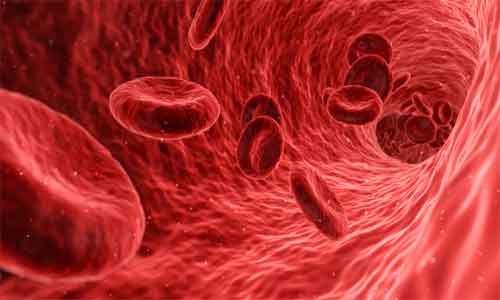British physiologist William Harvey (1628) first of all expressed the plan of special type of system within the body. This system is called the blood circulatory system. In our body, this special system perform several functions like carrying food substances, respiratory gases, excretory wastes, and control body temperature and metabolic activities, prevent infection and coordinate different organs of the body. Human circulatory system consists of three components: blood, heart and vessels.
Blood is the special type of circulating fluid comprises a high concentrated ionic plasma and blood corpuscle that circulates in the heart, arteries, capillaries, and veins of the body carrying nutrients and oxygen to and bringing away waste products from all parts of the body. Blood is both a fluid and tissue, and technically, it carries liquid substances to all parts of the body which is pumped by the heart.
Properties of Blood
- Blood is an opaque dense, sticky fluid with bright red color.
- It is heavier than water and slightly alkaline.
- Blood accounts for 7-8% of the human body weight with an average density of approximately 1060 kg/m3.
- The average adult male contains a blood volume of 5-6 liters and female with 4.5-5.5 liters.
- It has pH value of 7.45, specific gravity of 1.05-1.06 and temperature of 36-370 C.
Components of Blood
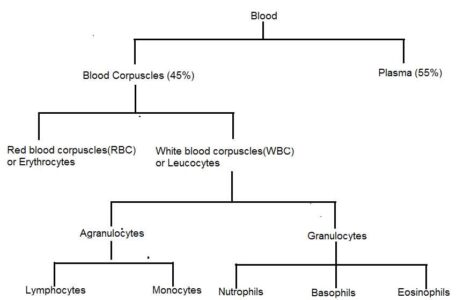
Blood Plasma
Plasma is the slightly alkaline, straw-colored/pale-yellow liquid component of blood. It is the intravascular fluid part of extracellular fluid which assemblage a massive amount of electrolytes, organic and inorganic substance. It has pH of 7.4. Plasma comprises 55% of blood volume.
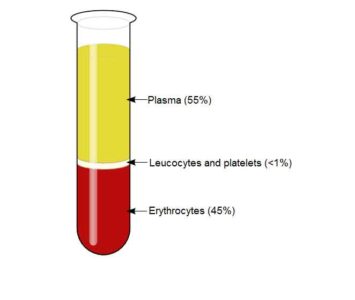
Image Showing Components of Blood: Image credit-Wikimedia commons
The adult body contains average 3 liters of plasma which comprises the 5% of the body weight. It is mostly 90-92% water by volume and contains 8-10% solid substances: The solid substances include:
- Dissolved proteins: prothrombin, albumins, globulins and fibrinogen
- Glucose
- Clotting factors
- Electrolytes: Na+, Ca2+, Mg2+, HCO3-, Cl– etc.
- Hormones
- Sugars
- Lipids
- Vitamins
- Minerals
- Enzymes
- Antibodies
- Urea and uric acid
- Creatinin
- Cholesterol, etc.
- It is also contains dissolved gases: CO2, O2, N2, etc.
Functions of Plasma
- Plasma holds the blood cells and maintains liquidity of blood.
- It is the chief transporting medium supplying water, O2 and metaboloites to all cells and also collects nitrogenous products and CO2 from the cells.
- Plasma plays significant roles in blood clotting, keeping of acid-base balance and maintains the body temperature.
- Plasma also serves as the protein reserve of our body.
Blood Corpuscles
A blood corpuscle, also called a haemocyte, is a cell produced by hematopoiesis and normally found in blood. These are called as corpuscles but not cells because they are unable to self division. Blood corpuscles add up to a total 45% of the blood tissue by volume. They sink into plasma. Blood corpuscles fall into the following three categories:
- Erythrocytes or Red blood corpuscles (RBC)
- Leukocytes or White blood corpuscles (WBC)
- Thrombocytes or platelets.
Erythrocytes or Red blood corpuscles (RBC)
Erythrocytes are also known as haematids which are small, biconcave, circular, red colored, a-nucleated, immobile, disc like structure found in plasma. The erythrocyte has a 7-8 µm diameter and 2.2 µm thicknesses. They are thicker at the edges than in the center. The erythrocytes do not have nucleus, RNA, mitochondria or endoplasmic reticulum. The erythrocytes of camel do not have nucleus among the mammals.
The cells are composed of a network of fats and proteins between which numerous pigments are present, called the hemoglobin which give the blood red color.
Hemoglobin composed of an iron containing pigment called heme and a protein called globin. The hemoglobin pigments combine with oxygen to form oxyhemoglobin in the lungs. Their plasma membranes are specialized for exchange of chloride and bicarbonate ions.
Their number is approximately 5.4 million per cubic mm in adult males and approximately 4.5 million per cubic mm in adult females. Their number is higher in early infancy. The erythrocytes are synthesized in the yolk sac and liver during fetus and bone marrows of the ribs, sternum and vertebrae after birth at the rate of 2 million cells per second.
The life span of the RBCs is only 120 days. When dead they are constantly disintegrated in the liver and spleen. The iron part is retained and the pigment is excreted in the bile juice as bilirubin.
Chemical Composition of Erythrocytes
They have 60-70% water by volume and 30-40% solid substances. Hemoglobin comprises of 90% of solid substances and other 10% consists of protein, phospholipid, cholesterol, inorganic salts, inorganic phosphate, potassium, etc.
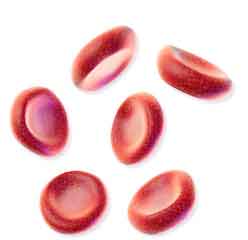
Erythrocytes: Image credit-Wikimedia commons
Functions of Eruthrocytes
- They carry O2 in the form of oxyhemoglobin from the respiratory organs to all cells of the body.
- They also carry small amount of CO2 in the form of potassium bicarbonate from the tissue cells to the respiratory organs.
- They maintain the viscosity of the blood.
- The hemoglobin and other intercellular component act as buffer to maintain acid-base balance.
- The disintegration of hemoglobin leads to formation of many other pigments like the bilirubin, biliverdin, etc. in the liver.
- Their plasma membrane contains antigens which are responsible for human blood grouping.
Leucocytes or White Blood Corpuscles (WBC)
Leukocytes or White blood corpuscles (WBC) are transparent, nucleated, amoeboid, granular or agranular, irregular shaped blood corpuscles found in plasma. These are known as mobile defensive units of the body. The amoeboid nature of the leukocytes helps them to squeeze through the walls of the blood vessels in order to engulf bacteria.
They lack hemoglobin and are therefore colorless and hence called the white blood cells. They are comparatively larger than RBC and have average 7.5-20 µm diameter. Their cytoplasm contains various shape og nucleus. WBCs are less numerous, about 6-8 thousand per cubic mm of blood, i.e., the ratio of RBC to WBC is about 600:1.
Chemical composition of WBC:
They enrich of nucleoproteins, glycogens, lipids, cholesterol, ascorbic acid and proteolytic enzymes. WBCs are produced in spleen or yellow bone marrow and when worn out, they are degraded in the blood stream and engulfed by other phagocytes.
Types of WBC
- Granular leukocytes or granulocytes
- Agranular leukocytes or agranulocytes
Granular leucocytes or granulocytes: These are round cells that have granular cytoplasm and lobed nucleus in each. They are of three types based on the stains they take:
- Neutrophils
- Basophils and
- Eosinophils
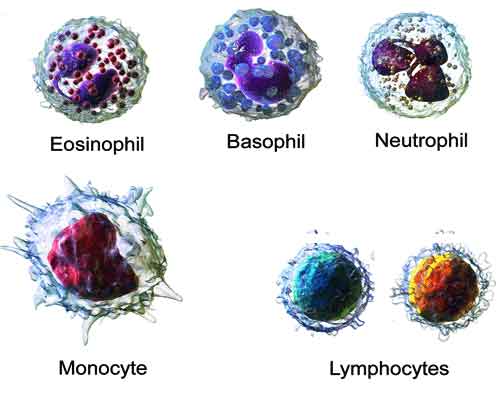
Different Types of White Blood Corpuscles: Image Credit-Wikimedia commons
Neutrophils: They contain neutral staining granules. The nucleus is 2-7 lobed. Their number is 3000-6000 per cubic mm. Their life span is 12 hours to 3 days. Their function is to kill the bacteria through the process of phagocytosis.
Basophils: They contain granules that take basic stain. The nucleus is variously lobed. Their number is 25 to 200 per cubic mm. Their life span is 9 to 18 months. The cytoplasmic granules contain heparin, which perform anti-coagulating function.
Eosinophils: They contain granules that take acidic stains like eosin. The nucleus is 2-3 lobed. Their number is 100 to 400 per cubic mm. Their life span is 3 to 5 days. They have anti-allergic properties.
Agranulocytes or agranulocytes
They usually contain clear cytoplasm and anucleus which is not lobed. They are of two types based on their origin:
- Monocytes and
- Lymphocytes
Monocytes: They are produced in the bone marrow. They have a large kidney-shaped nucleus. Their number is 100-700 per cubic mm. Their life span is 10-12 hours. They perform tissue macrophages feeding on damaged tissues.
Lymphocytes: They are produced in the lymph system. They have large nucleus and occupies most of the cells. They form 25% of total leucocytes. Their life span is 100-120 days. The perform phagocytosis process to kill bacteria and produce antibody.
Functions of Leucocytes
- The WBCs, mainly the neutrophils and lymphocytes engulf the bacteria by the process of phagocytoss. Thus they form the first line defense against germs such as bacteria and viruses.
- They involve in the production of antibodies that neutralize, kill or poison the germs. These are called microscopic soldiers.
- Basophils produce heperis which prevent blood clotting within vessels.
- Eosiniphills protect the body against allergies.
Thrombocytes or platelets
The thrombocytes or platelets are the smallest, colorless, non-nucleated cells of blood. These are minute, circular or round or rod shaped blood cells having diameter of 2-4 µm. Their number is 150000-350000 per micro liter of blood. They are formed in the bone marrow by segmentation of the cytoplasm of cells known as megakaryocytes, the largest cells of the bone marrow. The average life span is normally just 5 to 9 days. They lack a nucleus and are incapable of cell division.
The main chemical components are protein and phospholipids. Their cytoplasm contains actin, myosin, glycogen, lysosome and dense and alpha granules. Their plasma membrane harshly folded for holding of collagen and fibrinogen proteins. They are easy to clump and easy to disintegrate and thus easy liberation of clotting enzyme thrombokinase.
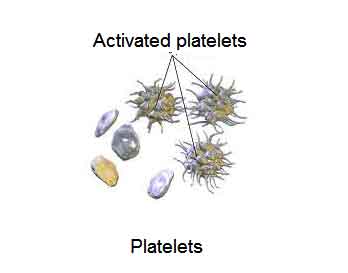
Image credits: Wikimedia commons
Functions of Platelets
- They form homeostasis plug to stop bleeding.
- They contribute substances essential for the normal coagulation of the blood and they cause the shrinking or retraction of a clot after it has been formed.
- They can kill or destroy carbon particles, immune compleces, and virus particles through the phagocytosis process.
- They can store of 5HT (5-hydroxytrypytamine) and histamine which are released when platelets disintegrate; these amines will then act on blood vessels.
Functions of Blood
- Blood helps to transport various gases. In this case, RBC and blood plasma convey O2 from the lungs to the various tissues. They also carry CO2 from the body tissues to the lungs for exhalation.
- Blood collects different types of digested food and nutrition such as glucose, amino acids, fatty acids and glycerol, vitamins, minerals and water from the alimentary canal and distributes it to all parts of the body.
- Hormones are carried by the blood from the endocrine glands to the organs and tissues.
- Blood removes different types of waste products such as urea and uric acid from the cells through the excretion.
- The body temperature is also maintained by the blood.
- WBC or white blood corpuscles destroy the germ cells through the process of phagocytosis and antibody production and defend the body from infection and diseases.
- Blood helps to stop bleeding from the cuts by forming a clot. In this case, leukocytes often help in curing the wounds.
- Blood also prevents the body tissues from the dehydration by providing adequate amount of water to the cells.
- Blood plays noteworthy role in keep hold of homoeostasis of the body.
- Blood can control pH of the body fluid by making buffer of alkali and acid.

